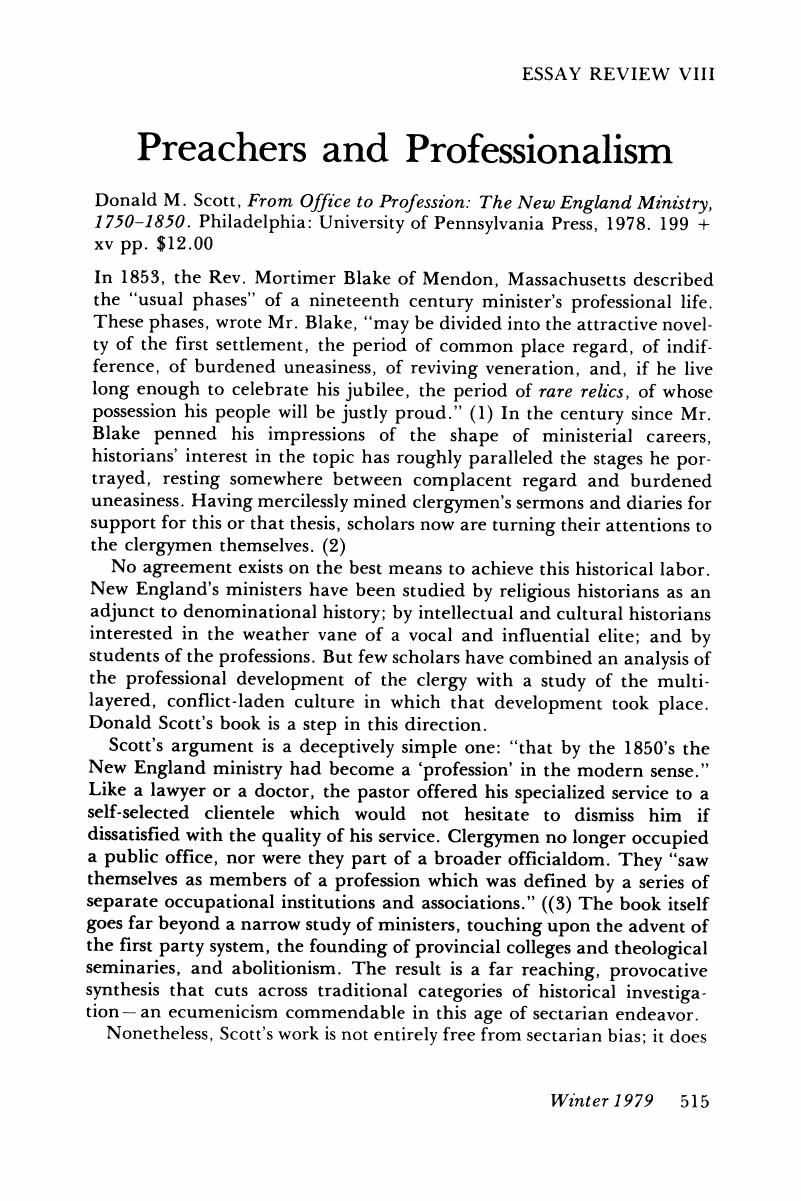No CrossRef data available.
Published online by Cambridge University Press: 24 February 2017

1 Blake, Mortimer, A Centurial History of the Mendon Association of Congregational Ministers (Boston, 1853), p. 155.Google Scholar
2 The best and most recent work would include Hall, David, The Faithful Shepherd (Williamsburg, 1972); Calhoun, Daniel, Professional Lives in America (Cambridge, Mass., 1965); Youngs, William T. Jr., God's Messengers (Baltimore, 1976); Schmotter, James, “Ministerial Careers in Eighteenth Century New England,” Journal of Social History, 9 (Winter, 1975): 249–267; Douglas, Ann, The Feminization of American Culture (New York, 1977).Google Scholar
3 Scott, , From Office to Profession, p. xi.Google Scholar
4 Ibid., p. xii.Google Scholar
5 The Revolution of American Conservatism: The Federalist Party in the Era of Jeffersonian Democracy (New York, 1965).Google Scholar
6 Scott, , From Office To Profession, p. 34.Google Scholar
7 Ibid., pp. 165 fn., 169 fn., 192 fn.Google Scholar
8 Ibid., p. 166 fn.Google Scholar
9 “The Strangeness of the American Education Society: Indigent Students and the New Charity, 1815–1840,” History of Education Quarterly, II (Spring, 1971): 3–22, and Paupers and Scholars: The Transformation of Student Life in Nineteenth-Century New England (New York, 1975).Google Scholar
10 For lawyers, see Gawalt, Gerald W., “Sources of Anti-Lawyer Sentiment in Massachusetts, 1740–1840,” American Journal of Legal History, 14 (October, 1970): 283–307; for doctors, Rothstein, William G., American Physicians in the Nineteenth Century: From Sects to Science (Baltimore and London, 1972).CrossRefGoogle Scholar
11 Potts, David B., “Students and the Social History of American Higher Education,” History of Education Quarterly, 15 (Fall, 1975): 319. A recent dissertation by Colin Burke suggests that for lower income occupations the burden of higher education costs, expressed as a percentage of total income, reached its highest point in the 1820's. Even if a student worked full time during his vacations and received not only free tuition but half of his room and board, he could not put himself through four years of college. “The Quiet Influence: The American Colleges and Their Students” (Ph.D. dissertation, Washington University, 1973): 67, 71–88.CrossRefGoogle Scholar
12 Scott, , From Office To Profession, pp. 154–155.Google Scholar
13 For an incisive look at the problems facing students of the professions, see Johnson's, William R. review essay “Professions in Process: Doctors and Teachers in American Culture,” History of Education Quarterly, 15 (Summer, 1975): 185–199. Haskell's, Thomas L. recent and extremely valuable The Emergence of Professional Social Science (Urbana, III., 1977) includes an excellent analysis of the expansion of the professions in the nineteenth century.CrossRefGoogle Scholar